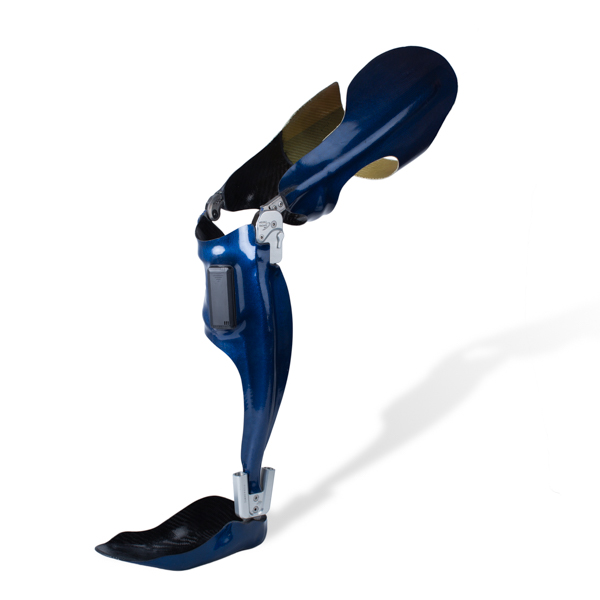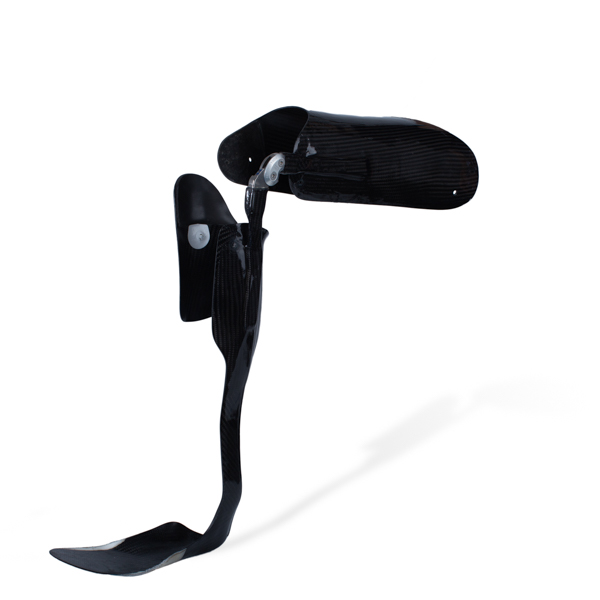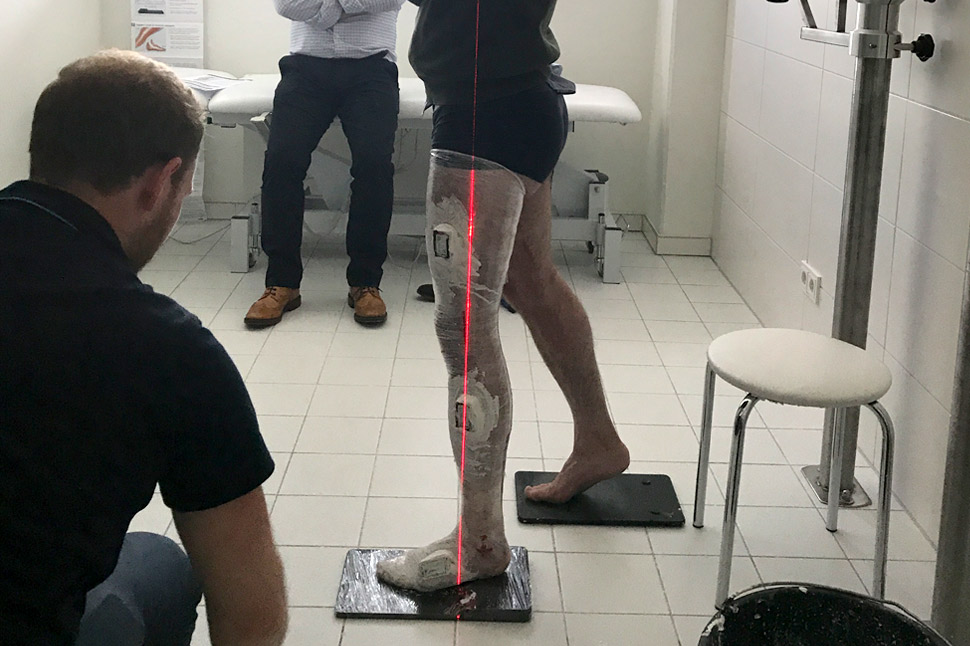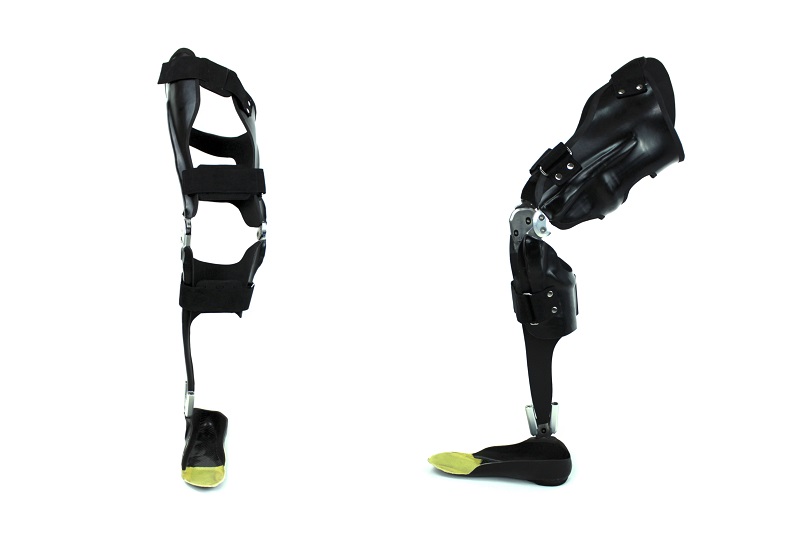A Knee Ankle Foot Orthosis, or KAFO, is an entire leg orthosis that spans the knee, ankle and foot. It is prescribed to assist and stabilise the muscles of the leg, particularly for patients with muscle-weakening conditions or paralysis. The most common causes of muscle weakness are post-polio syndrome, muscular dystrophy, multiple sclerosis and spinal cord injury. KAFOs work to:
It is best advised to choose supportive, comfortable shoes to wear with your KAFO to make the most of the benefits.
Until recently the only KAFO that was available was fixed with a locking knee joint. While they provide the needed stability to the knee, it can lead to muscle atrophy (muscle wastage through inactivity). Other disadvantages include unnecessary energy expenditure and a non-cosmetic walk.
Recently, Free Walk stance control orthoses have become available which can automatically lock and unlock at the right time in the gait cycle. These are lightweight and allow for a more natural gait while ensuring that leg muscles are also still being used.

Carbon Fibre KAFO – incredibly strong yet lightweight to help reduce energy expenditure. The reduced bulk also means it can fit within a wider range of shoes.
Otto Bock E-MAG Active KAFO – lower limb orthosis which electromagnetically locks and unlocks the knee during the gait cycle.
Neuro HiTronic Knee System - state-of-the-art orthosis technology developed in Germany with stance phase protection and microhydraulics.
One of our specialised orthotists will be able to advise on the KAFO best suited to your needs and preference. Give us a call or drop us an email to book a consultation today.

Unlike traditional KAFOs with their locked leg brace, “stance control” KAFOs allow the wearer to walk far more naturally. The brace locks and unlocks at just the right time; so it is locked while standing but allows the knee to be in free motion during the swing phase of normal walking.
The London Orthotic Consultancy has recently become accredited to start manufacturing in-house bespoke KAFOs using technology developed by leading orthopaedic technology company Fior & Gentz in Germany. They are created using joint sensors connected to a microprocessor which can lock and unlock the joint depending on which stage of the gait cycle the wearer is in. For example, when the wearer’s leg is lifted off the ground and swinging in the air – swing phase – it needs to be unlocked. Similarly, when a person is standing on the leg – stance phase – the joint needs to be mechanically stable and is locked into position.

The neuro-tronic system knee joint is controlled electromechanically either by a pressure sensor under the foot of the orthosis or by motion sensors integrated into the controller.
These KAFOs are made from direct-milled titanium and have one joint instead of the conventional two on either side. They are lighter, intuitive and smooth out the gait cycle to create a more natural walk.
Clinicians at LOC are now fully accredited to carry out Fior & Gentz methods of neuro-tronic KAFO production. Your orthotist will talk you through the best solution for your specific condition and your personal needs and preference.
LOC technician Simon and orthotists David and Sam underwent their three-day training workshop with Fior & Gentz. You can read about their trip to Luneberg, Germany in our news post.
If you think you might benefit from our new KAFO technology and our bespoke in-house service, give us a call or drop us an email to book a consultation today.

We have the following facilities and amenities at our Kingston Upon Thames location:
We also have the Gait Laboratory for orthotics patients and Onsite Manufacturing for speedy turnarounds and adjustments whilst you wait.
An insole is a contoured orthotic device which alters the characteristics and biomechanics of the foot and ankle area. Biomechanics are concerned with mechanical laws and how they affect the living body, especially the musculoskeletal system.
They are removable devices, often made from plastic, that are designed to fit inside a shoe to provide additional support for your feet. As well as offering shock absorption, an insole can help distribute the weight of your body more effectively across the foot and can be made bespoke to cover a range of biomechanical conditions.
If you have symptoms in your feet, ankles, hips or your lower back that are intermittent or were not there to start with in early life, and have started to cause you pain over a period of time, bespoke orthotic insoles could be an excellent option.
If you have already tried rest, icing, compression and elevation and your feet have not recovered, we recommend a biomechanical assessment to consider the possibility of insoles. They are a non-invasive approach to treatment and in many cases, are a great option for symptoms that are not severe enough to warrant surgical intervention. Alternatively, they can be considered as an option prior to surgery.
We will send patients away when an insole is not appropriate, if a patient is suffering with iliotibial band syndrome for example, the problem can be helped with physiotherapy and a stretching programme. That’s what our biomechanical assessment is all about; determining whether there would be any benefit from altering the alignment of your feet.

“It’s life-changing, my swimming coach has even remarked what a difference my treatment has made" Read how pectus bracing treatment helped to correct Aris' complex chest deformity, involving a combination of pectus excavatum, pectus carinatum and rib flaring.

Cerebral palsy patient Lucas sees significant improvement in his walking after only six months in his new custom Ankle Foot Orthoses (AFOs), designed by Professor Saeed Forghany in our Manchester clinic. Hear how a detailed gait analysis and bespoke AFOs significantly improved Lucas's gait and comfort.

Freddie’s positional plagiocephaly was treated successfully with the LOCBand Lite, going from 11mm to 2mm after four months in his helmet.

Adult club foot (talipes) patient Natasha says, "I cannot stress how amazing my AFOs are and how they have changed so much for me. The support they give me allows me to walk without crutches outside the house for the first time in over fifteen years."

Diagnosed with adolescent idiopathic scoliosis at 14 years old, Polly and mum Zoe looked to the LOC Scoliosis Brace to help her curve and avoid surgery at a later date.

LOC opens its first clinic in Northern Ireland, LOC Belfast, offer non-surgical orthotic treatment for scoliosis, pectus carinatum and pectus excavatum. Here, we will also be able to provide orthotic treatments for a range of adult and paediatric lower limb conditions including cerebral palsy, spina bifida, hypermobility, stroke, post-polio syndrome, and multiple sclerosis.

Mum Natalie shares her experience of having both her identical twins diagnosed with craniosynostosis. Ella and Nina had surgery at Great Ormond Street Hospital before going through cranial remoulding therapy at the London Orthotic Consultancy.

See how a thorough gait analysis and a correctly-fitted, bespoke Reciprocating Gait Orthosis (RGO) helped Ted, a spinal surgery and cancer survivor, improve his rehabilitation and mobility goals, getting him back on his feet again.